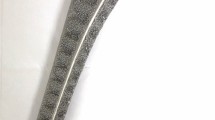Abstract
At the Orthopaedic Department of the University of Basel, a total of 540 cemented Müller titanium alloy (Ti6Al7Nb) Straight Stems were inserted between 1989 and 1993. A cohort of 120 consecutive patients (66 women, 54 men) with 126 prostheses operated on between March and December 1989 were followed clinically and radiologically in a prospective manner for a mean observation time of 9.1 years. In all cases, the Müller titanium alloy Straight Stem was combined with the senior author’s (E.W.M.) Press-Fit Cup. The mean age of the patients at surgery was 66 (range 43–93) years. Fourty patients (41 hips) died, 9 were interviewed by telephone, none was ‘lost to follow-up’. Seventy-one patients with 76 hip replacements were available for the follow-up. Four hips had been revised: two of them due to aseptic loosening of the femoral component, one because of a late infection – all after 9 years – and one owing to a periprosthetic fracture after 6 years. The 9-year overall survivorship is 96.8%, and for aseptic loosening of the stem 98.4%. None of the cups had to be revised for aseptic loosening. The clinical result (according to Merle d’Aubigné) was excellent and good in 88%, moderate in 8%, and poor in 4%. The radiological analysis showed no osteolysis or radiolucent lines in 59 prostheses (78%). Nine stems (12%) showed a radiolucent line. Focal osteolysis was detected in 8 cases (10%) in one or more Gruen zones. The distribution of the osteolyses shows that predominantly zones VII, VI, V, and II are affected in decreasing frequency. No osteolysis was detected on the acetabular side. Our results do not confirm the high rate of osteolysis and revisions with the Müller titanium alloy Straight Stem presented by some other institutions. The verdict on a specific endoprosthetic implant must be made by combined assessment of the design, the implant surface condition, the material, the cement, the cementing procedure and the operative technique. The statement made in earlier publications that cemented titanium alloy should not be used as a femoral stem prosthesis should be reconsidered.
Similar content being viewed by others
Author information
Authors and Affiliations
Additional information
Received: 9 June 2000
Rights and permissions
About this article
Cite this article
Acklin, Y., Berli, B., Frick, W. et al. Nine-year results of Müller cemented titanium Straight Stems in total hip replacement. Arch Orth Traum Surg 121, 391–398 (2001). https://doi.org/10.1007/s004020000254
Issue Date:
DOI: https://doi.org/10.1007/s004020000254




